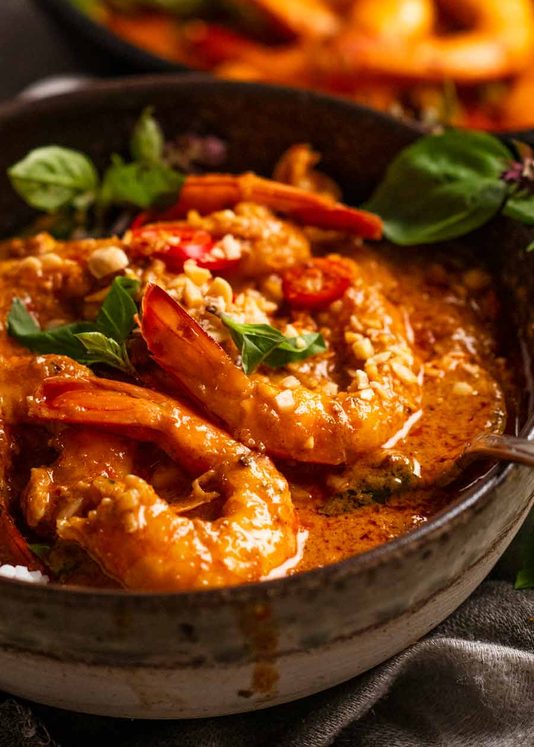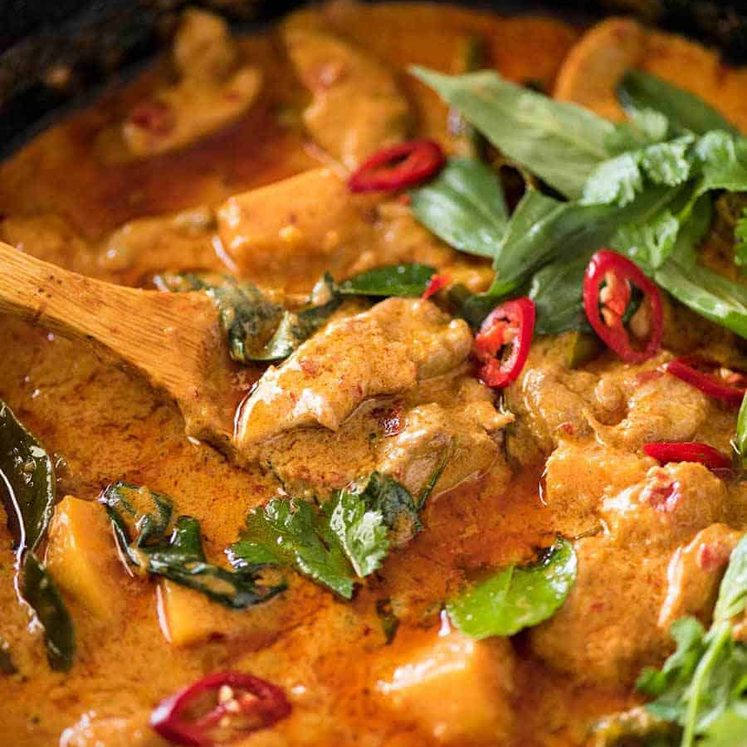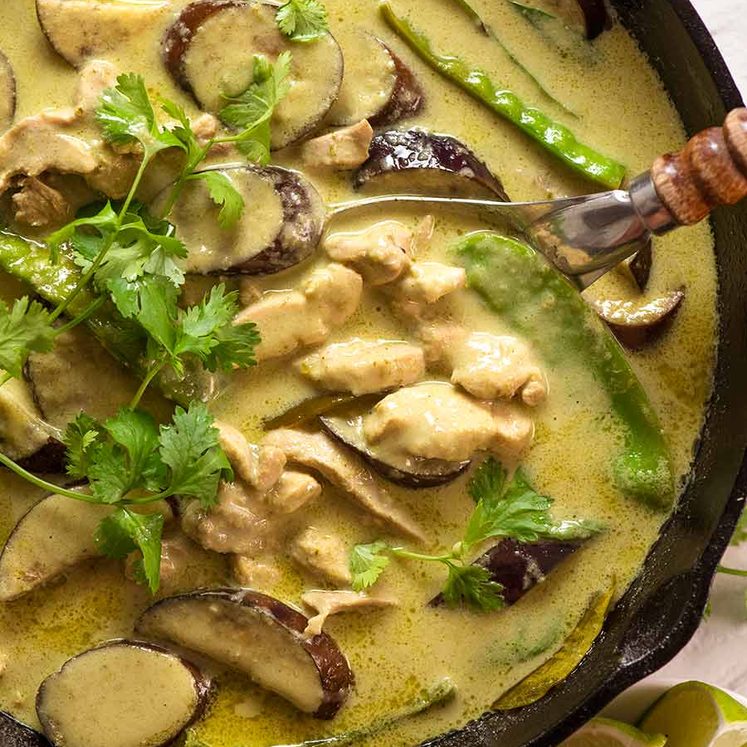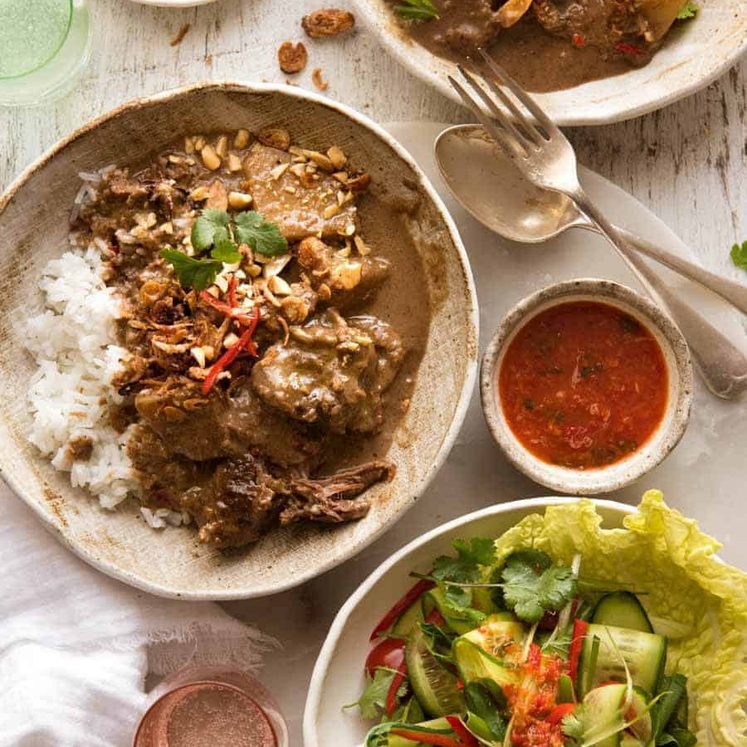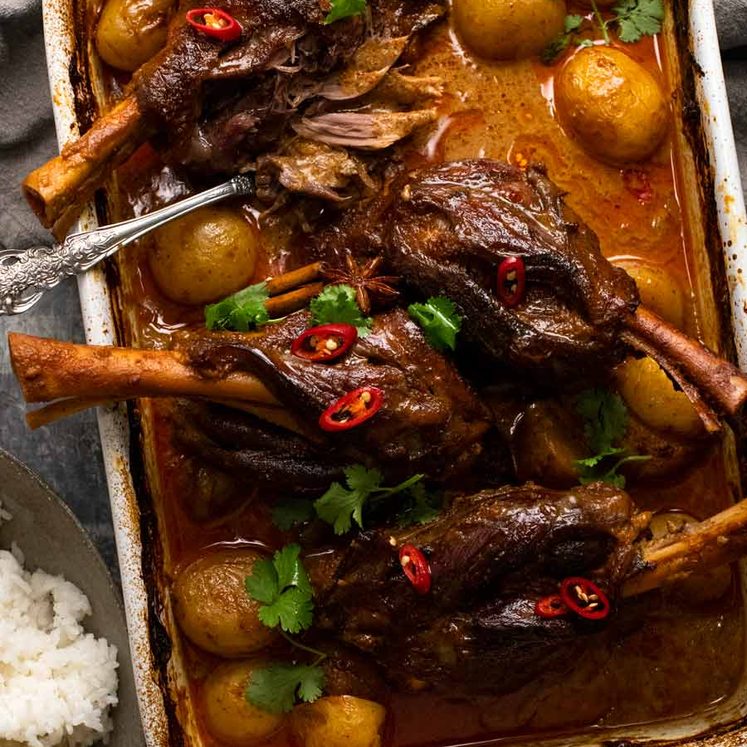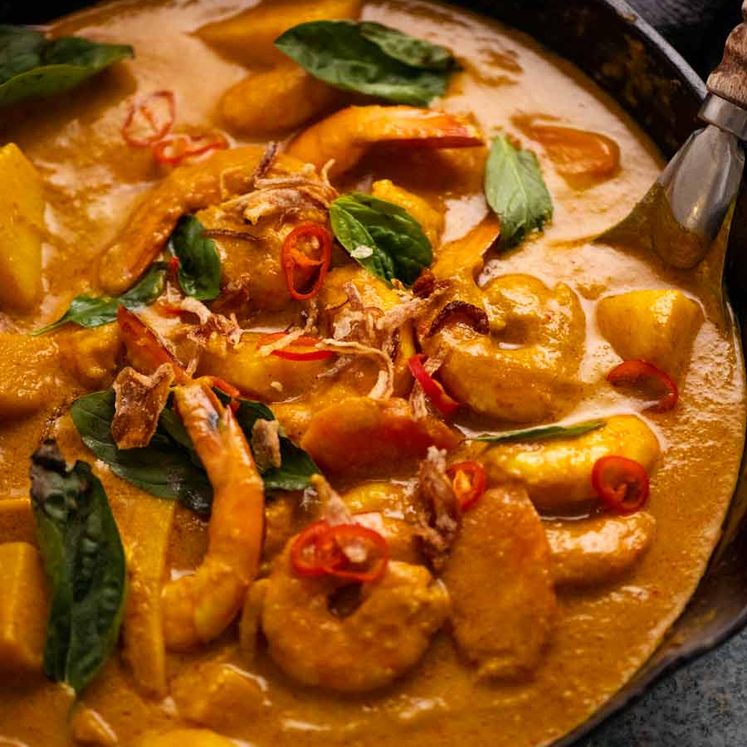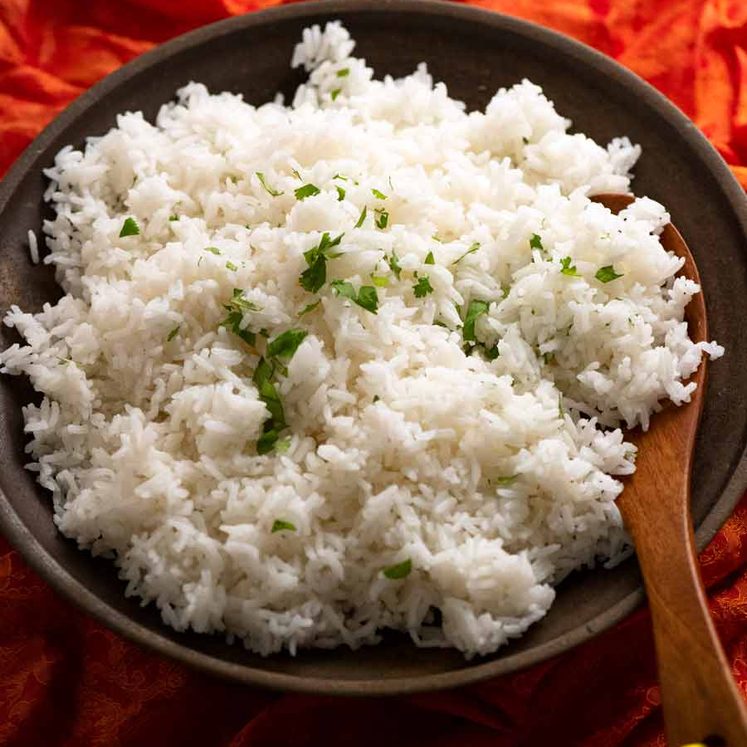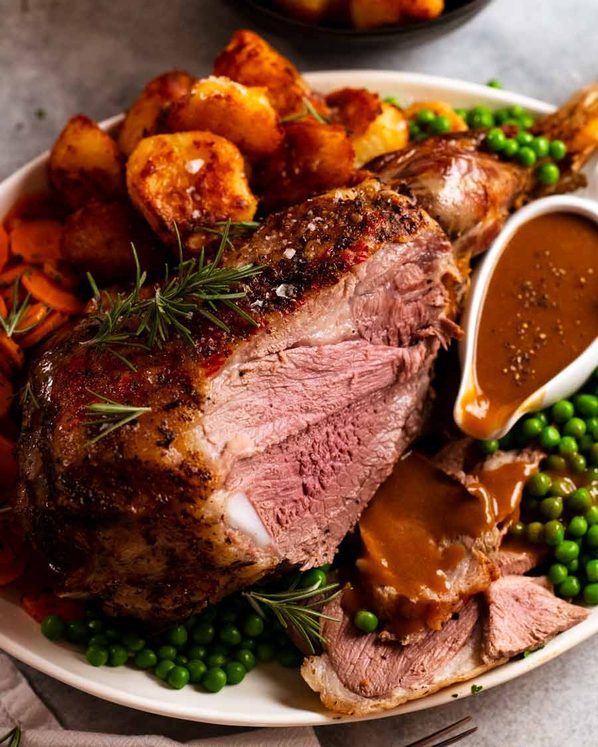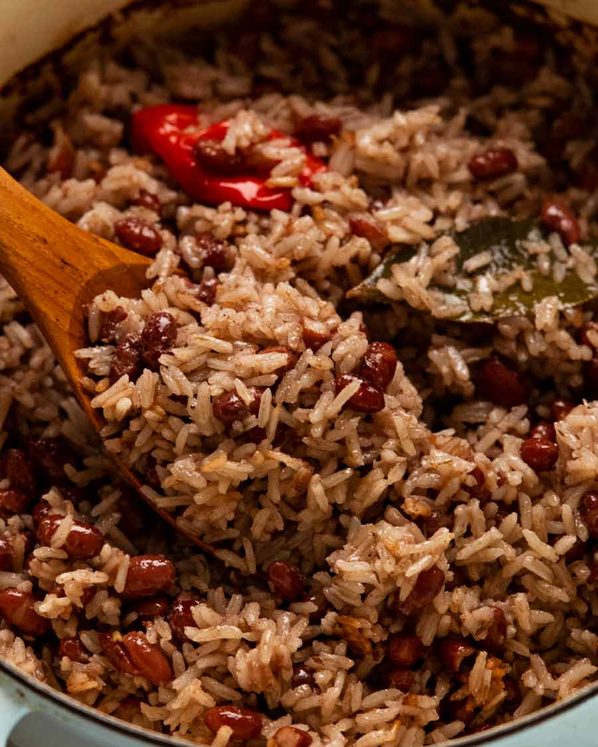This is a real Panang Curry recipe for curry connoisseurs who adore authentic Thai food! It’s made using a homemade Panang Curry paste which is easy to make but will likely call for a trip to the Asian store. But if you truly want the best, it’s worth it. You can’t get good Panang curry in jars!
Make this creamy coconut Panang curry with either prawns/shrimp or chicken. Both are great!
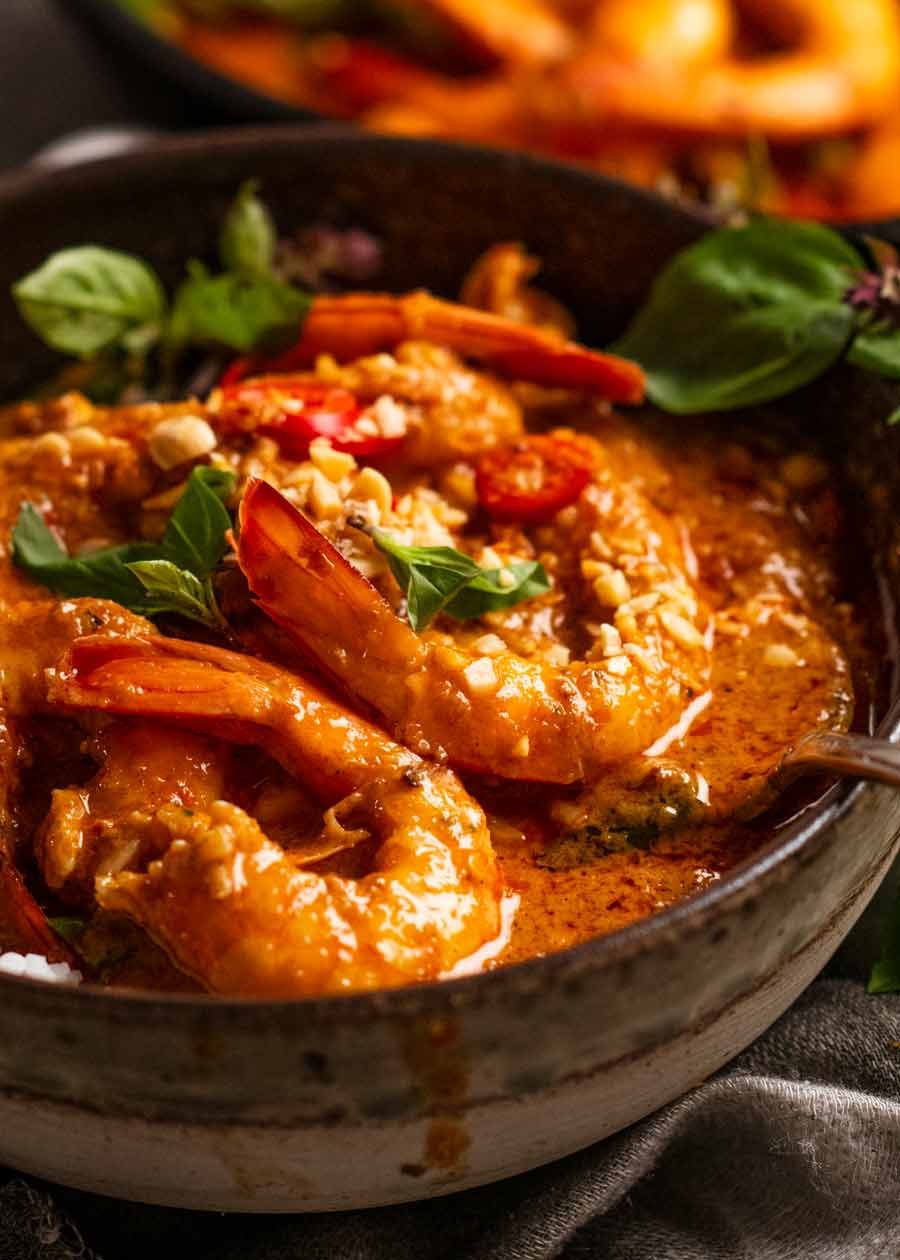
I only make Panang curry from scratch
This is a recipe for Thai Panang curry that is entirely made from scratch, including a homemade Panang curry paste. While I’ll happily make Thai Red and Green curry using my favourite curry paste from a jar, nothing compares to a Panang Curry paste when you make it yourself from fresh ingredients!
Even the Panang curry paste by my favourite Maesri brand falls too short compared to homemade. Well, maybe that’s going too far. It makes a tasty enough curry. But not a real deal Panang curry!
What Panang curry tastes like
Panang Curry tastes like a more intense version of Thai Red Curry. While it has similar ingredients, Panang curry is a bit stronger, richer, sweeter and thicker than Red Curry, as well as slightly nutty thanks to the addition of ground peanuts in the paste.
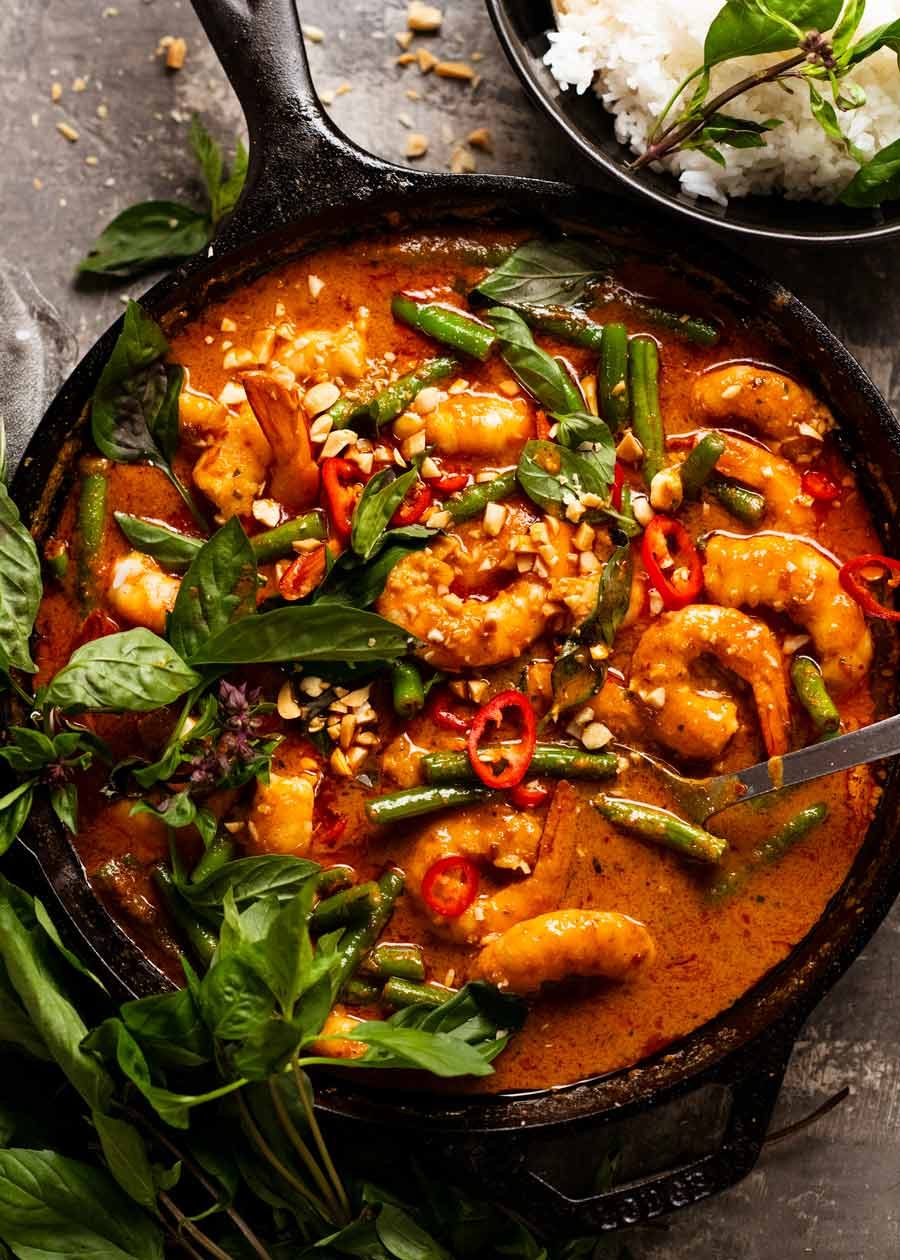
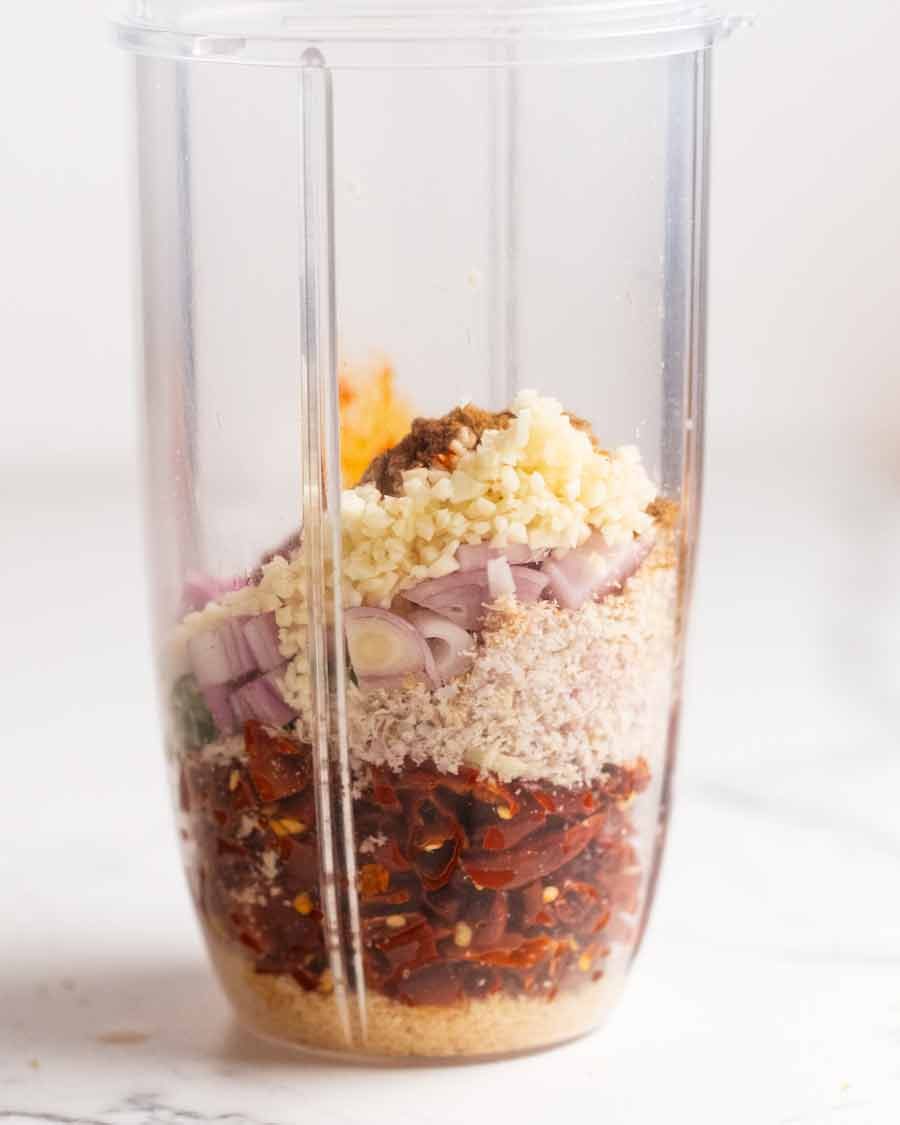
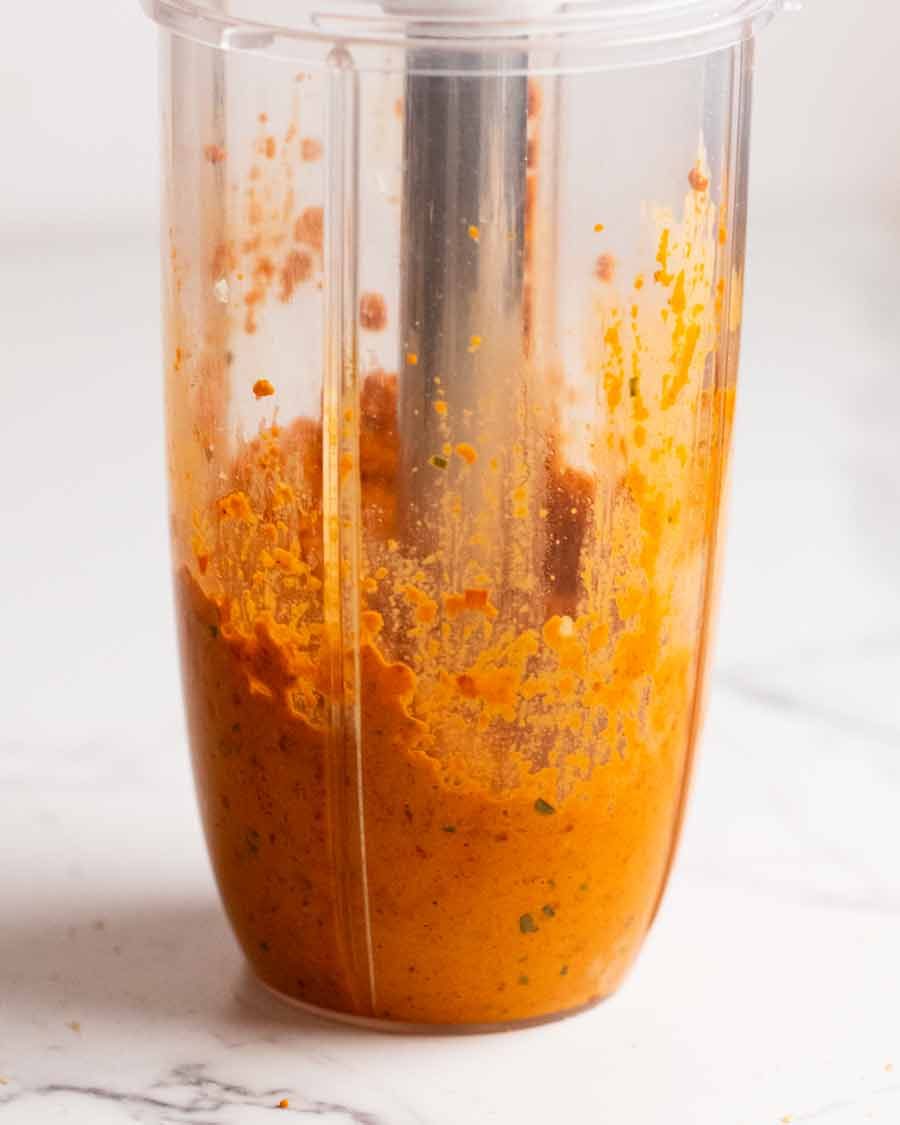
Panang curry is spicy. Deal with it!
Panang curry is spicy. But unlike most other curry recipes, you cannot reduce the spiciness without losing flavour because chillies are the key ingredient for Penang curry sauce.
How spicy, you ask? Thais would class this Panang curry as medium or “not so spicy”. For Westerners, it’s probably getting up towards hot. But not volcanic. General consensus amongst my team is that it’s a 7 out of 10 on the spicy scale. The only other curry on my website that hits this level of spiciness is Vindaloo, if that’s a useful comparable for you.
So if you can’t handle spicy food, I suggest you give Panang Curry a miss and make a milder Thai Yellow Curry or Massaman Curry instead!
* Spiciness testing: My team and I worked on this Panang curry recipe a LOT. We did so many variations to stress test the spiciness and we are all in agreement that if you reduce the chillis to reduce spiciness, you lose flavour and it’s not Panang curry. We ended up creating a recipe using milder Chinese chillies rather than spicy Thai ones, to get enough sauce flavour without blowing our heads off.
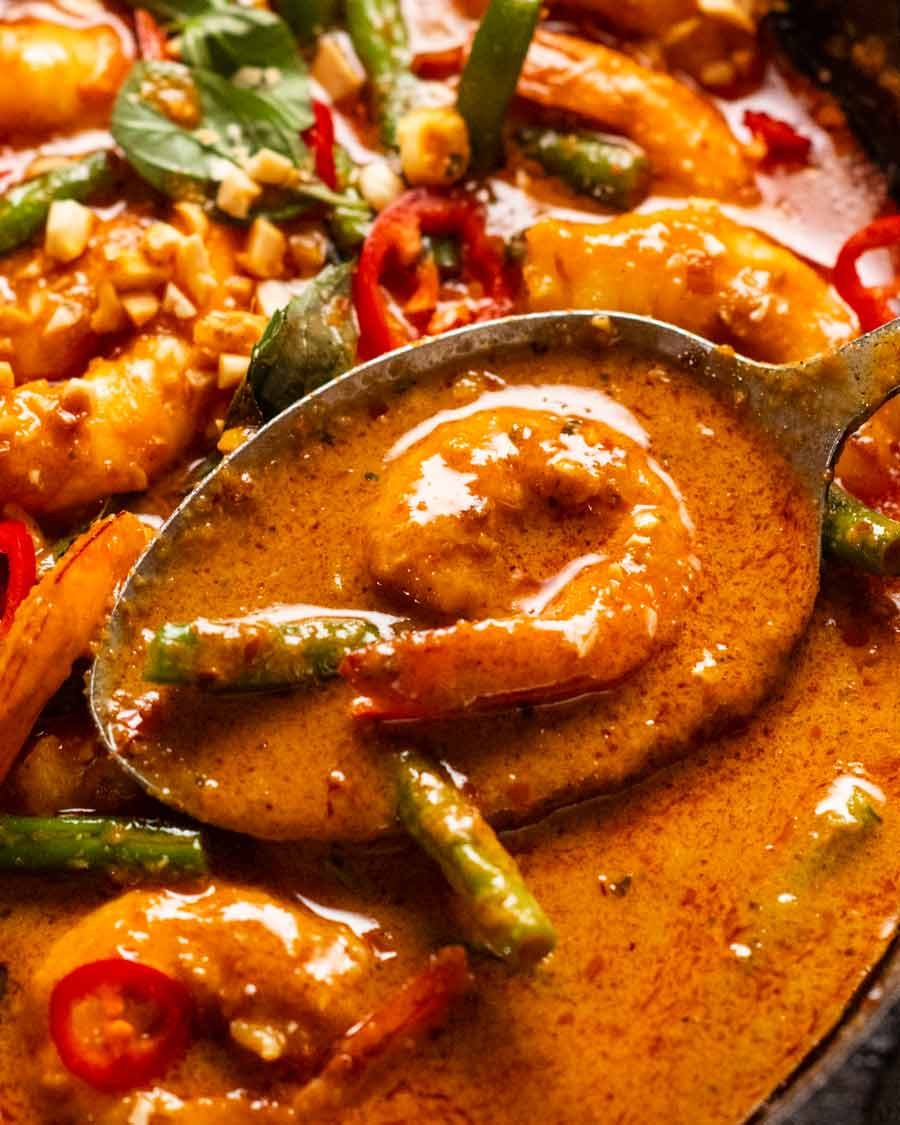
OK, due warning on the topic of spiciness given. On to the recipe!
Panang curry ingredients
First, I’ll run through the beautiful fresh ingredients for the homemade Panang curry paste. Then all the good stuff that goes in the curry!
Panang curry paste ingredients
There’s a fair few Asian specific ingredients here, but familiar ingredients to those who have made other homemade Thai curries. In particular, Thai Red Curry – because the ingredients are virtually the same!
It will require a trip to the Asian store, though you can actually get everything at Harris Farms and the larger grocery stores in Australia, with the exception of shrimp paste (but there’s a substitute for that).
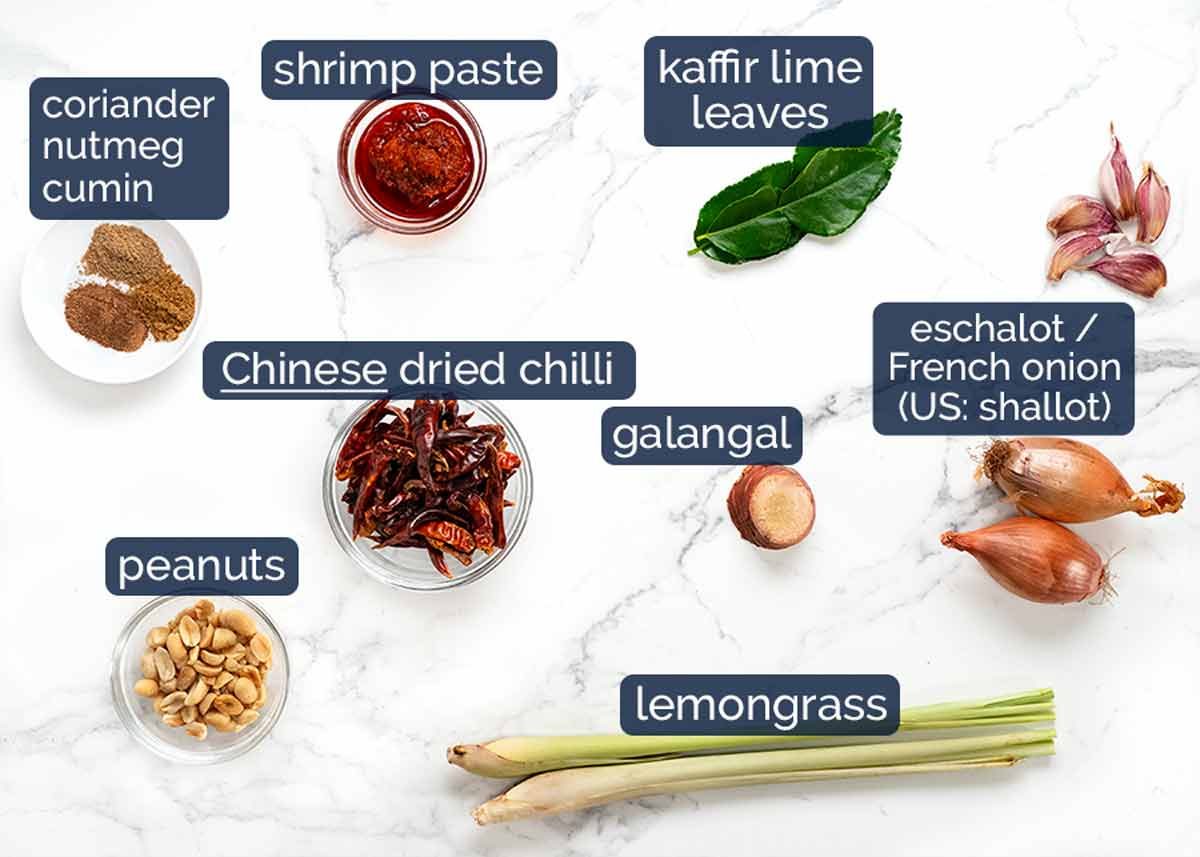
-
Dried chilli – Key ingredient, so discussed below. Don’t get this wrong – you will regret it! 🔥
-
Lemongrass – Fresh is best but if you can’t get it, use 1 tablespoon of lemongrass paste instead.
-
Galangal – looks like ginger but is more citrusy and harder. It’s pretty tough so best to grate to ensure your curry paste is smooth, otherwise you risk lumps in your sauce. You can find it in Asian stores + some grocery stores in Australia (Harris Farms and some Woolworths sell it). Substitute: use the same amount of ginger + 1/4 tsp lime zest.
-
Shrimp paste in bean oil – I use Por Kwan Shrimp Paste in Bean Oil, pictured below, the most popular one sold at Asian grocery stores here in Australia. Substitute with 1 1/2 tsp belacan dried shrimp paste, roughly chopped (even sold at Woolies in Australia!) + 1 tsp oil + 1 tsp fish sauce + 1 garlic clove + 1 tsp miso, if you can – any type). Use in place of shrimp paste in recipe.
-
Kaffir lime leaves – Earthy lime flavour unlike anything else! Sold at Asian stores, Harris Farms & large grocery stores in Australia. Freezes 100% perfectly – used in Thai red curry, coconut rice, Thai meatballs.
-
Eschalot (US: Shallot) – Also known as French onions and called “shallots” in the US. They are like baby onions, but with purple-skinned flesh. Not to be confused with what some people in Australia call “shallots”, ie. the long green onions. Substitute with half a red onion.
-
Garlic – 5 whole cloves!
-
Peanuts – This is what gives the Panang curry the signature peanut-y flavour. Beats using a scoop of peanut butter any day!
-
Dried spices – Cumin, coriander and nutmeg.
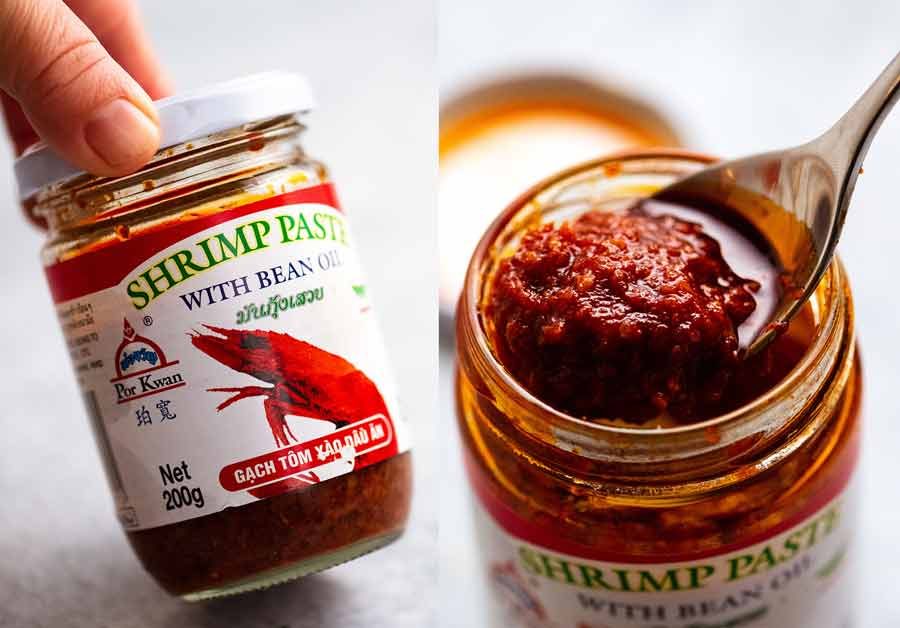
Dried chilli for Panang curry paste
Dried chilli is the key ingredient in Panang curry, for both sauce flavour and colour. It is also what makes Panang curry spicy. But if you reduce the chilli, you will lose sauce flavour. So as recommended above, if you can’t handle spicy food, it is best to give this a miss.
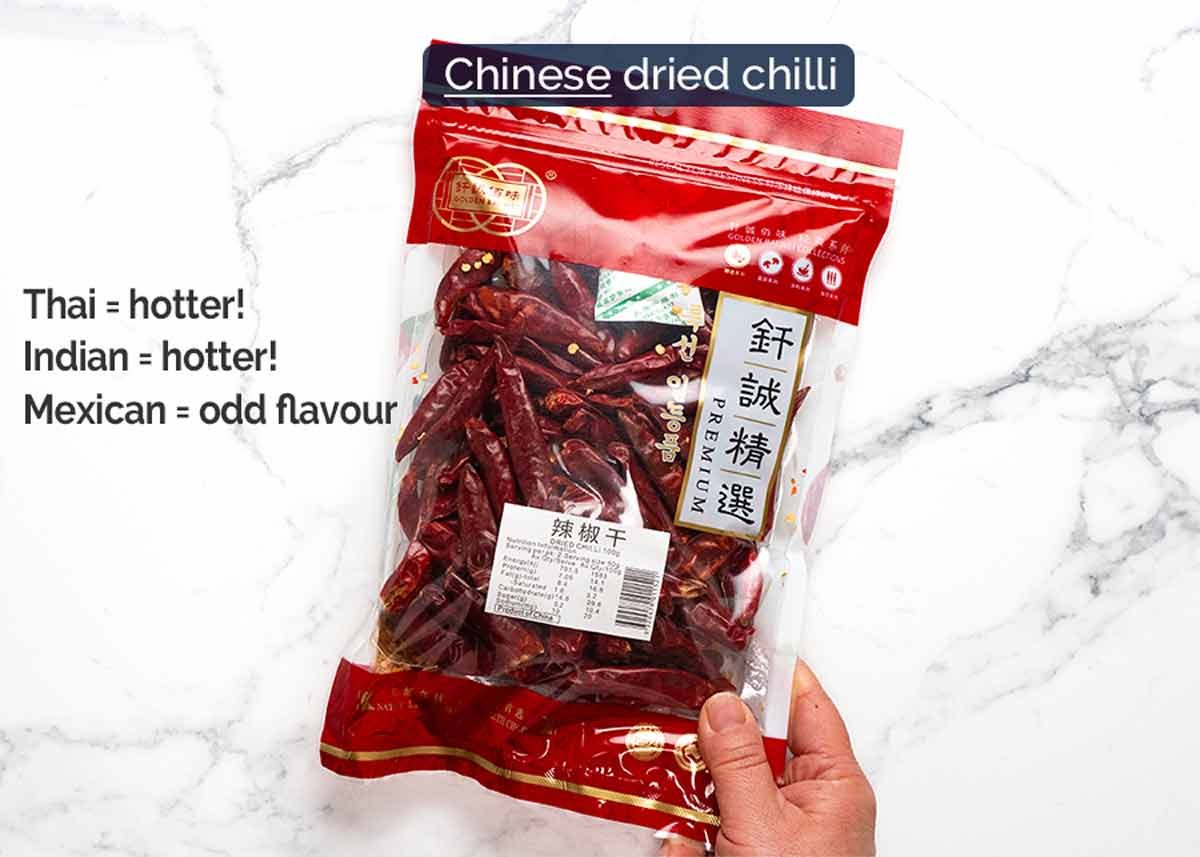
Chilli type matters!! Use Chinese dried chillies, not Thai or Indian! I know it sounds strange to tell you not to use Thai dried chillies but they are SUPER spicy and unlike Chinese chillis, they don’t reduce in spiciness much when cooked. Same with some Indian chillies, like kashmiri. Let’s just say my team and I put our bodies on the line to figure this out!!
* Check label for country of origin.* You want chillies from China. And even though the spiciness of Chinese chilli types and brands will vary, we found that the cooking process in this curry reduces the spiciness of the chillies so they end up being the same level of spiciness – even using Chinese chillies labelled hot and extra hot.
The brand I use is pictured above. It’s a very common brand here in Australia and not that expensive (~$3), sold in Asian stores and even some large grocery stores.
Amount to use – We need 1/2 cup chillies once chopped, so start with about 2/3 cup whole chillies. Dried chillies vary in length so the number you need will vary, from (say) 12 very large ones to 40 small ones. Get large ones if you can because we need to deseed them and it’s much faster to deal with 12 large ones than 40 small ones.
Be sure to deseed thoroughly – the seeds are where most of the spiciness is!
The protein – chicken or prawns/shrimp
The base recipe calls for fresh, whole prawns/shrimp. This is because I like to add my own touch by repurposing the heads to make an easy prawn stock for use in the sauce. This underlines the sweet, prawn-y flavours of this curry and catapults it into wow territory. However, we’ve also made it with chicken and it’s extremely good too!
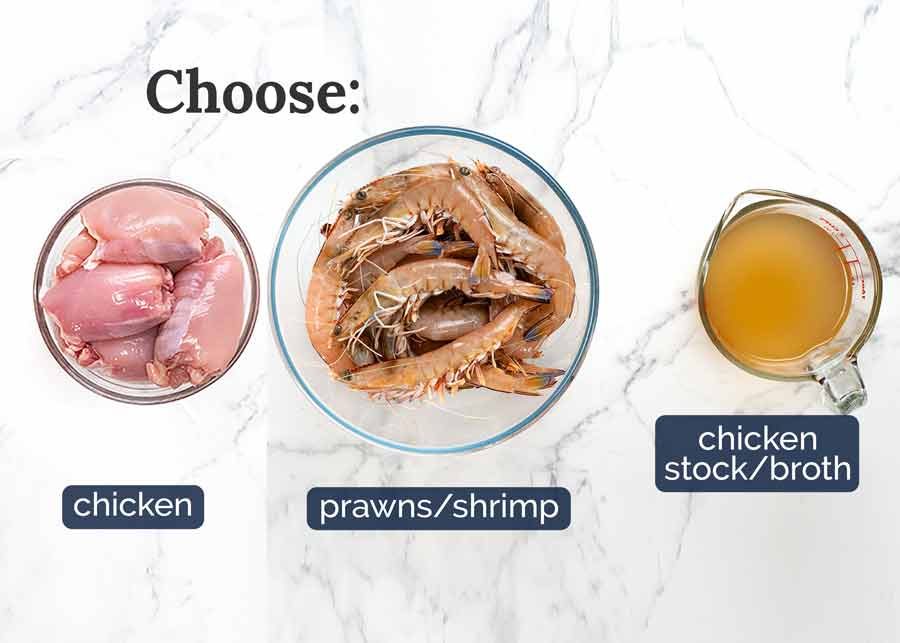
If you can’t get / don’t have / really can’t bear the thought of peeling your own prawns, it’s ok, you can use peeled prawns and skip making the prawn stock.
Chicken stock? Yes! Store bought fish/seafood stock is really not good. But chicken stock is much better, and gets infused with prawn flavour from the prawn heads (which is where most of the prawn flavour is!).
Panang curry sauce
Here’s what you need for the sauce and other add-ins for the curry.
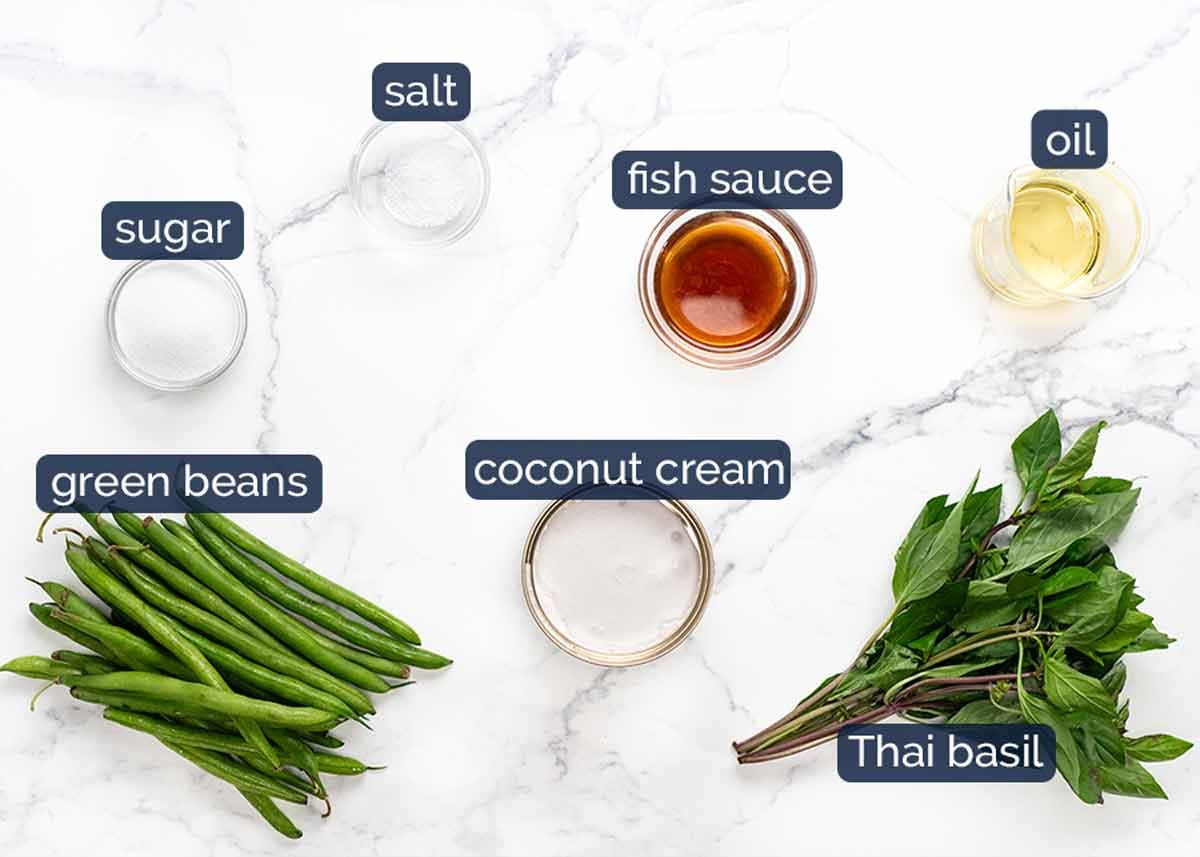
-
Coconut cream – More intense coconut flavour than using coconut milk, and thickens the sauce too. Full fat essential! No point using low-fat because fat is where all the flavour is.
-
Fish sauce – Provides most of the salt in the curry, but with more savoury flavour. We do add some salt too because if we only use fish sauce, it gets a bit too…well, fishy. 🙂
-
Sugar – Just a touch, because Thai food is all about balancing the sweet-salty-savoury!
-
Thai basil leaves – Fresh herb used in Thai cooking that tastes like Italian basil with a slight aniseed flavour. Substitute with Italian basil.
How to make Panang Curry
The making part is very straight forward and quite quick actually. The step that takes the longest is soaking the dried chillies!
Make prawn stock – if using prawns/shrimp
If you’re making Panang curry with prawns/shrimp, get the prawn stock going first. If you’re using chicken, you can skip this step.

-
15 minute simmer – Place chicken stock, prawn heads and shells in a saucepan. Simmer for 15 minutes, crushing the heads every now and then with a potato masher to extract as much flavour as you can.
-
Strain the stock and discard the prawn heads. We started with 1 1/2 cups of stock, you should end up with around 1 1/4 cups. Top up if you are short.
Then set the stock aside for 5 minutes to let the sediment settle to the bottom. We will avoid pouring that bottom layer into our sauce.
Curry paste

-
De-seed chillis – Cut the chillis in half then twist / tap / use chopsticks to remove all the seeds. Be thorough here – the seeds is where most of the spiciness is! I got slack one day and let’s just say I seriously regretted it.
-
Soak 30 minutes – Roughly chop the chillis then soak in boiling water for 30 minutes.
-
Drain and reserve the chilli soaking liquid. We will be using some for the curry paste.
-
Blitz – Put the peanuts into a jug just large enough to fit the head of a stick blender. Cover the jar with your hand to stop the peanuts from flying everywhere and blitz into a rough paste. Then add all the remaining curry paste ingredients and blitz until smooth. It only takes around 20 seconds or so.
Note: You can also use a small food processor. You’ll struggle to make this in a large food processor as there is not enough curry paste.
Making Panang curry
This part is nice and quick – about 10 minutes from start to finish!

-
Sauté curry paste – Cook the Panang Curry paste for around 5 minutes until it darkens in colour and is not wet and sloppy. This intensifies the flavour.
-
Sauce – Add the prawn stock, being careful to pour off just the clearer liquid and leaving the sediment behind. If using chicken as your protein, just add plain chicken stock/broth.
-
Add coconut cream, sugar, fish sauce and salt.
-
Add the beans then simmer for 2 minutes until the beans are half cooked.
-
Add prawns, stir, then simmer for another 2 minutes until the prawns are cooked. They cook quickly – and will keep cooking as we finish it!
-
Serve – Then finally, stir in the Thai basil leaves. Serve over jasmine rice garnished with chopped peanuts, chilli and more Thai basil leaves!

Another RecipeTin team effort!
This recipe is a RecipeTin team effort, one that I’m proud to say we created from scratch ourselves, using Panang Curry eaten in Thailand and at really reputable, authentic Thai restaurants here in Sydney as our benchmark.
We referenced many recipes during the course of our research, notably from highly regarded Thai food experts including David Thompson and Sujet Saenkham of the acclaimed Spice I Am restaurants, and YouTube videos from Thai home cooks. But we did a lot of experimentation and variations of this recipe ourselves to arrive at our final recipe, and make this a recipe accessible to people living outside Thailand.
In fact, this Panang Curry was subject to greater levels of testing than usual, including independent recipe testers, because this recipe was earmarked for my cookbook. A curry chapter that was removed at the last minute because my book was too big!😭
Anyway, I just wanted to put this big blue box here to acknowledge my teams’ efforts with this recipe, because curries are hard! Getting the spice balance just right is difficult, and you never know what the final flavour will be until right at the end. And because of the spiciness of this curry, testing it was extra painful – we tried so many different chillies!
Special shout out to my brother who was the driving force behind the development of this recipe, and Chef JB who’s probably made this curry more times than anyone else. We did it!
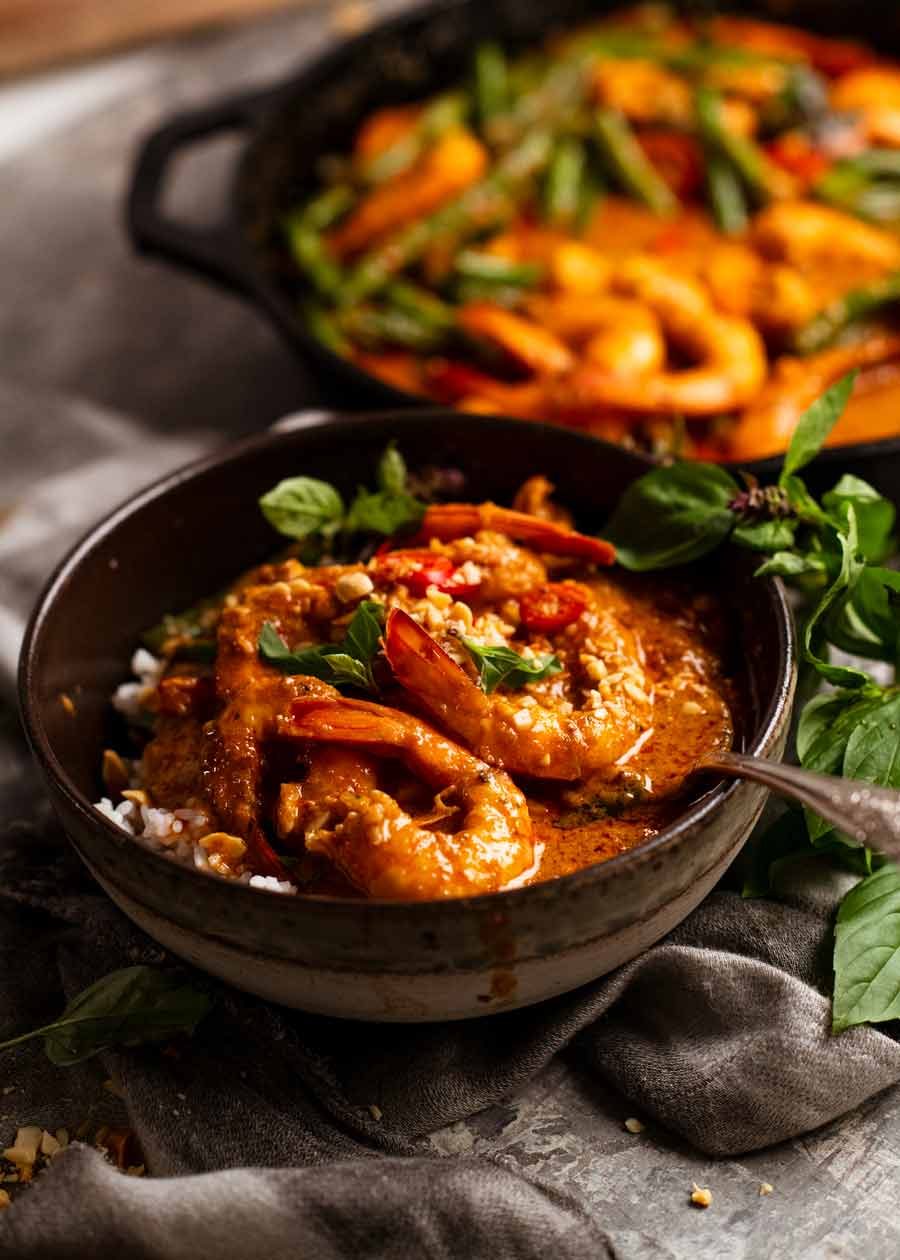
So, with the big blue box of thanks done, I hope those of you on the fence about trying this can have the confidence to make it knowing it’s been subject to extra thorough testing! We really do think this is an exceptional Panang Curry. You’d be hard pressed to find one as good other than at the really top tier Thai restaurants. In Sydney, I’d only recommend Long Chim and Spice I Am.
Remember – be brave with the chillies! Go on, you can do it! 😉 – Nagi x
Watch how to make it
Hungry for more? Subscribe to my newsletter and follow along on Facebook, Pinterest and Instagram for all of the latest updates.
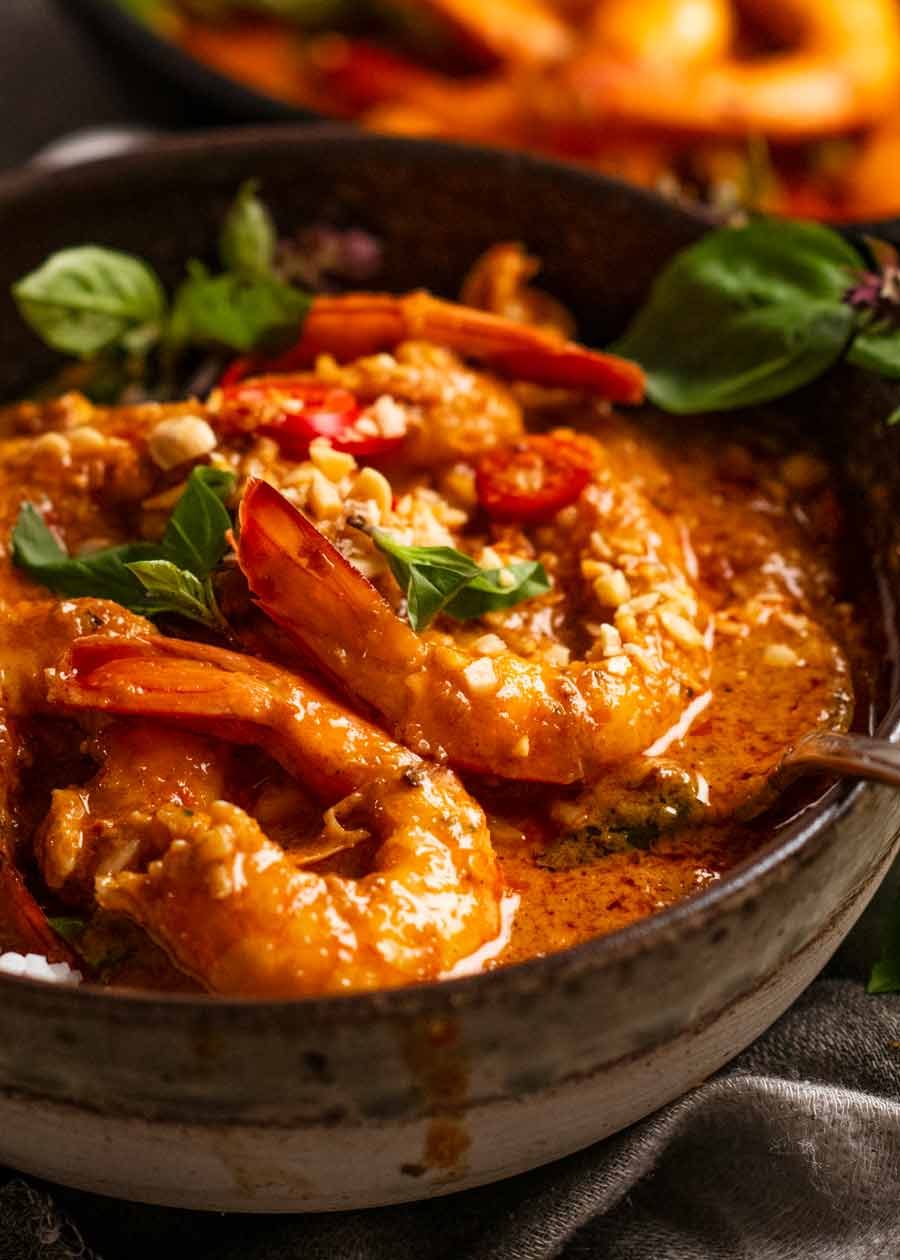
Panang Curry – real, from scratch
#wprm-recipe-rating-0 .wprm-rating-star.wprm-rating-star-full svg * { fill: #343434; }#wprm-recipe-rating-0 .wprm-rating-star.wprm-rating-star-33 svg * { fill: url(#wprm-recipe-rating-0-33); }#wprm-recipe-rating-0 .wprm-rating-star.wprm-rating-star-50 svg * { fill: url(#wprm-recipe-rating-0-50); }#wprm-recipe-rating-0 .wprm-rating-star.wprm-rating-star-66 svg * { fill: url(#wprm-recipe-rating-0-66); }linearGradient#wprm-recipe-rating-0-33 stop { stop-color: #343434; }linearGradient#wprm-recipe-rating-0-50 stop { stop-color: #343434; }linearGradient#wprm-recipe-rating-0-66 stop { stop-color: #343434; }
Ingredients
Protein – choose ONE:
- 700g/ 1.4 lbwhole raw prawns/shrimp(ie shell on), medium ~8cm / 3″long – Note 1
- 350g / 12 ozboneless, skinless chicken thighs, cut into 7mm/ 1/3″ slices
For prawn stock (shrimp):
- 1 1/2cupschicken stock/broth, low-sodium (not fish/seafood – Note 2)
Curry paste:
- 2/3cupdried Chinese chillies (not Thai!)(24 x 6cm/2.5″ long, 1/2 cup (15g) once deseeded chopped) – Note 3
- 3tbsproasted peanuts unsalted
- 2lemongrass stems, finely grated (2 x 20cm/8″ lengths) – Note 4
- 2eschalots, roughly chopped (1/2 cup)
- 1tbspgalangal, finely grated (~1.5cm / 0.6″ piece) – Note 5
- 5garlic cloves, finely minced
- 1 1/2tbspshrimp paste in bean oil – Note 6
- 1/2tspeach ground coriander, cumin, nutmeg
- 1tbsp (packed)finely sliced kaffir lime leaves (~ 6 leaves) – Note 7
Curry:
- 3tbspcanola oil
- 1 1/4cupscoconut cream, full-fat (standard Aus 270ml small can ok)
- 3 1/2tspwhite sugar
- 4 1/2tspfish sauce
- 1/4tspcooking/kosher salt
- 200g/7ozgreen beans, trimmed, cut in half (~1 1/2 cups)
- 12Thai basil leaves – Note 8
SERVING and GARNISHES
- Jasmin rice
- 2tbspunsalted peanuts, finely chopped
- Red cayenne peppers, finely sliced (optional)
- Thai basil leaves, 3 leaves per serving – Note 8
Instructions
Prawn stock:
-
Simmer – Peel and devein prawns, reserving heads and shells. Bring chicken stock to a simmer in a small pot on high heat. Add prawn heads & shells, bring back to a simmer, then reduce to low heat. Simmer uncovered for 15 minutes, periodically crushing the heads lightly with a potato masher and skimming off any orange scum.
-
Strain into a jug, discarding heads. You should have just over 300 ml (1 1/4 cups) of stock. Leave undisturbed to let the sediment settle (~ 5min+).
Curry paste:
-
Cut chillies in half then tap / squeeze out seeds (use a chopstick if needed for stubborn seeds). Discard seeds (spicy!). Chop chilli.
-
Soak dried chillis in 2 cups of boiling water for 30 minutes. Drain in a colander, reserve soaking liquid.
-
Peanuts – Put peanuts in a tall jar that comfortably fits the head of a stick blender (or use a small blender). Cover the jar opening with your hand and pulse until finely ground.
-
Blitz paste – Add drained chillis and remaining Curry Paste ingredients, along with 1/4 cup of the reserved chilli soaking liquid. Blend, scraping down the sides as you go, for about 30 seconds until smooth, using extra chilli water only if needed to help blend.
Cooking:
-
Cook curry paste – Heat oil in a large deep frying pan over medium-low heat. Cook curry paste for 5 minutes, stirring constantly. The paste should be drier, darker, smelling aromatic and no longer raw.
-
Sauce – Add 1 cup (250 ml) prawn stock, being careful to pour off just the clearer liquid and leaving the sediment behind. Stir in the coconut cream, sugar, fish sauce and salt. Mix in the green beans.
-
Simmer for 2 minutes until the sauce thickens and the beans are half cooked.
-
Add prawns, stir, then simmer for another 2 minutes until the prawns are cooked. Stir in the Thai basil leaves. The final taste should lean mostly savoury and sweet, and medium spiciness.
-
Serve over jasmine rice garnished with chopped peanuts, chilli and more Thai basil leaves!
Recipe Notes:
1. Proteins – I think juicy prawns go particularly well with panang curry, plus you get to re-purpose the heads to get free, bonus flavour into the stock which makes this really special. If using pre-peeled prawns, using 350g/12 oz and skip the stock making steps.Chicken – Recipe works perfectly with chicken too! Use 350g/12oz, thinly sliced. Skip the stock making steps, cook chicken as per recipe does with prawns.2. Chicken stock? Yes! Store bought fish/seafood stock is really not good. But chicken stock is much better, and gets infused with prawn flavour from the prawn heads (which is where most of the prawn flavour is!).3. Use Chinese dried chillies, not Thai or Indian! I know it sounds strange to tell you to avoid Thai dried chillies but they are SUPER spicy and don’t reduce in spiciness much when cooked. Same with some Indian ones are too (like kashmiri). My team and I did a lot of testing around chilli types for this curry re: excessive spiciness.Check label for country of origin, use Chinese chillies. Though the spiciness of Chinese chilli types and brands will vary, I found that the cooking process in this curry reduces the spiciness of the chillies so they end up being the same level of spiciness. Be brave! Try not to reduce the chilli too much because they are also a key flavouring for the sauce. If you can’t handle spicy food, I suggest skipping this recipe!Quantity – Dried chillies vary in length so the number you need will vary, from (say) 12 very large ones to 40 small ones for 2/3 cup when whole (20g, with seeds in). You need enough so you have 1/2 cup (15 g) chillies once chopped / deseeded. Be sure to deseed thoroughly – the seeds are where most of the spiciness is!4. Lemongrass prep – cut the reedy end off, we’re only using the white and pale green part, around the bottom 20cm/8″. Trim root off, peel off reedy outer layer. Then grate using a microplane, discard stringy bits left. Sub: Fresh is best here but if you can’t get it, use 1 tablespoon of lemongrass paste instead.5. Galangal – looks like ginger but is more citrusy and harder. It’s pretty tough so best to grate to ensure your curry paste is smooth. You can find it in Asian stores + some grocery stores in Australia (Harris Farms and some Woolworths sell it). Sub: use the same amount of ginger + 1/4 tsp lime zest.6. Shrimp paste in bean oil – I use Por Kwan Shrimp Paste in Bean Oil, the most popular one sold at Asian grocery stores here in Australia. Substitute with 1 1/2 tsp belacan dried shrimp paste, roughly chopped (even sold at Woolies in Australia!) + 1 tsp oil + 1 tsp fish sauce + 1 garlic clove + 1 tsp miso, if you can – any type). Use in place of shrimp paste in recipe.7. Kaffir lime leaves – Earthy lime flavour unlike anything else! Sold at Asian stores, Harris Farms & large grocery stores in Australia. Freezes 100% perfectly – used in Thai red curry, coconut rice, Thai meatballs.8. Thai basil leaves – Fresh herb used in Thai cooking that tastes like Italian basil with a slight aniseed flavour. Sub with Italian basil.9. Leftovers will keep for 3 days in the fridge or 3 months in the freezer. Keep basil separate – it degrades once stirred in.Nutrition per serving assuming 5 servings, excluding rice.
I adore Thai curries
See?
Life of Dozer
Getting fitted for a special reader dinner coming up next week at the Four Seasons hotel in Sydney! YES, Dozer will be waddling around a ballroom in his tux. 😂 There’s still some tickets available – see below for information!

Tickets here for a dinner hosted by Dymocks book store at the Four Seasons Hotel in Sydney on Thursday 10th August. Ticket price includes a 3 course meal developed with the Chef at the hotel in collaboration with our very own Chef JB, as well as all beverages!

